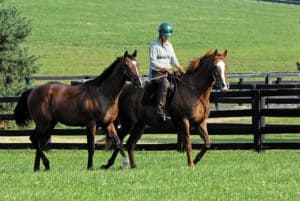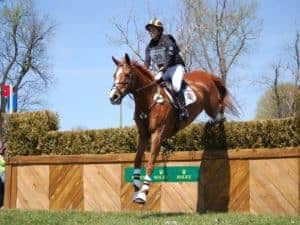Managing Laminitic Pain in Horses: What’s New?

Pain in horses is a complex state. Laminitis exemplifies this complexity, involving multiple overlapping pain pathways that can be difficult to manage.
“It is so complex that we continue to struggle with keeping on top of it in cases of laminitis due to our lack of safe, efficacious protocols,” said Alonso Guedes, DVM, MS, PhD, Dipl. ACVAA, during his presentation at the 2024 American Association of Equine Practitioners Convention, held Dec. 7-11, in Orlando, Florida. Guedes is professor of anesthesia and pain medicine at the University of Minnesota’s College of Veterinary Medicine, in St. Paul.
“Our inability to manage the severe, debilitating pain is the single most common reason for electing euthanasia in cases of laminitis,” he added. Laminitis is a painful condition in which the sensitive tissues anchoring the coffin bone inside the hoof capsule—called the lamellae or laminae—become inflamed and compromised. In advanced cases this damage can cause the coffin bone to rotate or sink as the internal support fails. Guedes described the multiple mechanisms involved in the onset of pain in horses with laminitis, including:
- Mechanical disruption of the lamellar tissues that cause nociceptive pain (the traditional acute pain many of us think of);
- Inflammation of the lamellae that causes inflammatory pain;
- Systemic inflammation with the release of cytokines (proteins important in cell signaling), such as tumor necrosis factor-alpha (TNF-a). “This cytokine increases neuronal excitability, increasing the firing rate of sensory pain neurons,” Guedes said.
Laminitic horses also suffer from changes in peripheral neurons that transmit signals between the central nervous system and the rest of the body. Changes in those fibers, the A-delta (d) myelinated fibers, and C fibers likely contribute to neuropathic pain. “Neuropathic pain is difficult to treat, it’s not very responsive to NSAIDs (non-steroidal anti-inflammatory drugs) or opioids, and the changes to the nerve fibers start early in laminitis,” he explained. Indeed, the significant overlap between nociceptive, neuropathic, and inflammatory (both local and systemic) pain is what makes laminitic pain so complex.
Assessing Laminitic Pain in Horses
Laminitic horses often show telltale signs—weight-shifting, a sawhorse stance, and appearing depressed at the back of the stall—but Guedes said there aren’t any validated methods for assessing laminitis pain in horses.
Subjectively, veterinarians can use a visual analog scale (VAS), which is essentially a line extending from 0 (no pain) to 10 (could not be more lame/painful). This method is fairly reliable between laypeople and veterinarians; however, people spending time with the horse might adapt to the horse’s behavior and misassign the grade, said Guedes. In other words, chronic pain can become a horse’s “new normal.”
Analgesic Options for Laminitic Pain in Horses
Guedes said there is no doubt multimodal analgesia is more efficacious than a single modality. “A single modality can’t treat all the different types of pain,” he said.
But other than NSAIDs, what options do veterinarians have?
Tramadol
“(Tramadol) inhibits mu-opioid receptors as well as serotonin and norepinephrine reuptake in pain pathways, and it decreases levels of TNF-a,” said Guedes. “So, even by itself tramadol has multiple mechanisms of action.”
In one study, researchers examined the effect of 5 mg per kg of body weight of oral tramadol twice daily for seven days. Using force plates they measured the horses’ discomfort by how often horses off-loaded their limbs, shifting weight from foot to foot. The researchers noticed only a transient decrease in off-loading and, by Day 7 of treatment, the horses began off-loading again at baseline levels. In a second study using 10 mg/kg, however, scientists identified more sustained pain relief with no adverse effects.
Ketamine
Ketamine blocks N-methyl-d-aspartate (NMDA, an amino acid derivative) receptors, which amplify pain signals. “Even with a stimulus that shouldn’t produce very much pain, NMDA receptors enhance it,” said Guedes. “Ketamine blocks the NMDA receptors located in peripheral nerve endings contacting the laminae and within the spinal cord, modulating pain signals.”
Ketamine might also suppress TNF-a production. Researchers on one study evaluated a combination of ketamine and tramadol in 15 chronic laminitis cases. They administered ketamine at a rate of 0.6 mg/kg intravenously every six hours for the first three days of the study. Again, using the force plates, the investigators found that the horses decreased their off-loading frequency for the entire seven-day treatment period and the first three days beyond cessation of tramadol.
Gabapentin
Guedes explained that gabapentin blocks voltage– gated calcium channels in nerve fibers transmitting pain signals toward the brain and from the brain to the spinal cord. Veterinarians typically treat horses with 20 mg/kg, which can be effective, but researchers on recent studies in horses use doses as high as 120 mg/kg without producing adverse events.
Others
Researchers studying an oligofructose model of laminitis (not clinical cases) found that delivering local anesthetics via continuous peripheral nerve block with dilute bupivacaine yielded positive results and reduced the animals’ off-loading frequency.
Alternatively, liposomal bupivacaine delivered via abaxial nerve block (placed at the base of the proximal sesamoid bones, which are located at the back of the fetlock, to numb the structures below the fetlock) provided 24 hours of analgesia in an experimental model of hoof pain.
Scientists are examining soluble epoxide hydrolase (sEH) inhibitors in human clinical trials for neuropathic pain. Guedes said some preliminary work conducted in horses with laminitis has yielded promising results.
Take-Home Message
Veterinarians should recognize the complexity of laminitic pain in horses—including the nociceptive, neuropathic, and inflammatory components—and take a multimodal approach to pain management.

Related Articles
Stay on top of the most recent Horse Health news with


















